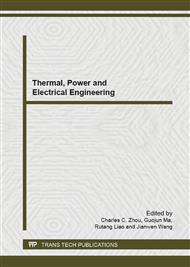p.719
p.726
p.731
p.738
p.745
p.752
p.757
p.762
p.767
Wind Farm Voltage Control Scheme to Improve Dynamic Voltage Stability
Abstract:
Dynamic voltage instability is one of the new problems with the fast development of wind farm clusters. This text is about the improvement of voltage stability of weak grid connected with wind turbine generators (WTGs). It focuses on the control strategy and mode of WTGs and dynamic reactive compensators during disturbance. Firstly, in order to propel WTGs outputting reactive power, the active control mode regarding both doubly fed induction generators (DFIGs) and permanent magnetic synchronous generators (PMSGs) is given. Secondly, the method of installing SVC at the terminal of part of WTGs is proposed. The selection of WTGs to install SVC is based on the sensitivity analysis. Thirdly, a coordinating method of various reactive sources is discussed. Finally, the comprehensive control logic under time series is listed. The simulation validates the methods above.
Info:
Periodical:
Pages:
745-751
Citation:
Online since:
August 2013
Authors:
Keywords:
Price:
Сopyright:
© 2013 Trans Tech Publications Ltd. All Rights Reserved
Share:
Citation:


